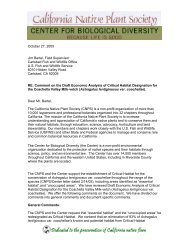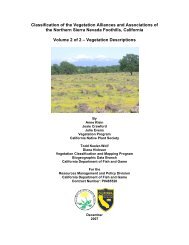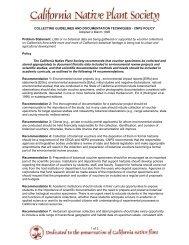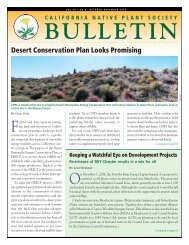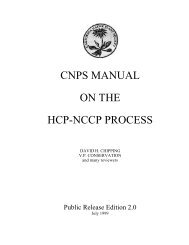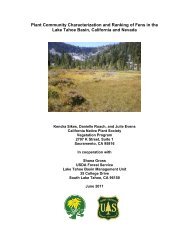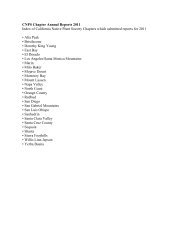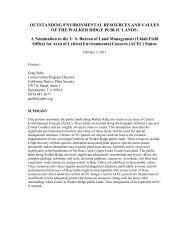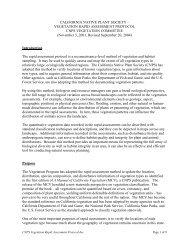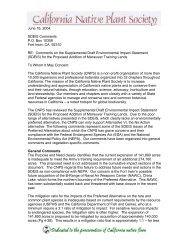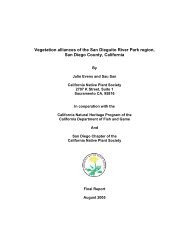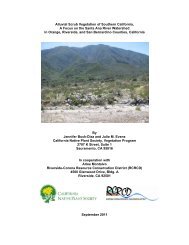David Magney Environmental Consulting - California Native Plant ...
David Magney Environmental Consulting - California Native Plant ...
David Magney Environmental Consulting - California Native Plant ...
Create successful ePaper yourself
Turn your PDF publications into a flip-book with our unique Google optimized e-Paper software.
Comments on Draft EIR for Newhall Ranch Mission Village Development<br />
DMEC Project No. 10-0181<br />
1/3/2011<br />
Page 40<br />
1. Failure of Reintroduction as a Viable Spineflower Mitigation Strategy<br />
D:\DMEC\Jobs\Friends_SantaClaraRiver\Newhall-MissionVillage\DMEC_comments_on_Newhall_MissionVillage_DEIR-20110103.doc<br />
DMEC<br />
There has been no study done or demonstration that reintroduction of the SFVS, or any Chorizanthe<br />
species, to previously unoccupied habitat or currently occupied habitat will actually work.<br />
Before destruction of any known part of the SFVS population is contemplated, much less permitted,<br />
demonstration that the SFVS seed bank can be successfully stored and sustainably reintroduced to the wild<br />
must be demonstrated. Fiedler (1991 52 ) surveyed the effectiveness of reintroduction of <strong>California</strong>n<br />
special-status plant species as a mitigation strategy and concluded that “it is suggested that because of the<br />
lack of or limited success of most of the transplantation, reintroduction, or restoration attempts<br />
documented, and the uncertainty of many of the on-going projects, the Endangered <strong>Plant</strong> Program of the<br />
<strong>California</strong> Department of Fish and Game's Natural Heritage Division should remain extremely cautious in<br />
any mitigation agreement that will allow any of these techniques to serve as mitigation for project impacts”.<br />
There are no data presented in this plan that the proposed mitigation for destruction of the SFVS seed bank<br />
outside of the preserve areas will work.<br />
In the Spineflower Draft Conservation Agreement (page 18), the authors state:<br />
“Although the reintroduction program is experimental at this stage, the parties consider such a<br />
program to be a feasible form of conservation at this juncture based upon available studies.”<br />
The authors do not cite any specific studies that validate their conclusion that a reintroduction program is<br />
feasible. There are no baseline data extant that collection and storage of the SFVS seedbank is a viable<br />
conservation strategy. There is no valid scientific logic presented to support the applicant’s assertion that<br />
reintroduction is a viable conservation plan for the spineflower.<br />
All knowledge and demonstration that reintroduction is a viable conservation strategy is deferred to the<br />
future and thus invalidates reintroduction as a viable mitigation strategy under CEQA Guidelines Section<br />
15126.4. Proceeding with reintroduction strategies with the current lack of knowledge that they are viable<br />
would result in the destruction of 6.32 acres (31 %) of mapped SFVS occurrences on the Newhall property<br />
and the associated SFVS seedbank underlying these known SFVS population occurrences. The destruction<br />
of this seedbank cannot be mitigated for with the current lack of ecological knowledge.<br />
The SCP puts much emphasis on further analysis that will be included in the Habitat Characterization Study.<br />
It is our understanding from email correspondence with Jodi McGraw, the designer of the proposed study<br />
that the habitat assessment or characterization was not implemented. If this is the case, then it is premature<br />
for preserve design and future management framework be constructed in the SCP since the basis for many<br />
of the restoration and proposed experimental trials depend on the results of this Study.<br />
It is not justified or reasonable that the SCP can recommend restoration and possible introduction when<br />
there is not enough scientific knowledge on what is suitable habitat for the SFVS.<br />
2. Lack of Knowledge About Genetics<br />
There is a lack of knowledge about genetic structure and diversity of the SFVS seedbank, which is needed<br />
for adequate management of SFVS abundance and diversity. As discussed extreme population fluctuations<br />
occur in spineflower populations. Germination of the SFVS seedbank typically occurs after late-fall and<br />
winter rains which results in winter and spring blooms, as in many other annual plant species. Research on<br />
52 Fiedler, P. 1991. Mitigation Related Transplantation, Translocation and Reintroduction Projects Involving Endangered and<br />
Threatened and Rare <strong>Plant</strong> Species in <strong>California</strong>. <strong>California</strong> Department of Fish and Game, Sacramento, <strong>California</strong>.



